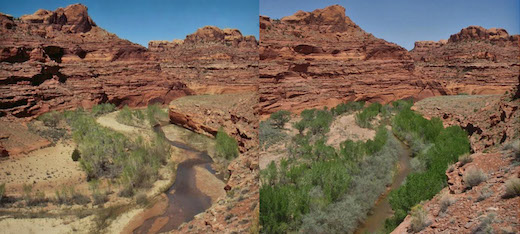by Bill Wolverton
 Escalante River, north of Choprock Canyon
Escalante River, north of Choprock Canyon (left) April 1991 — No Russian Olive present
(right) April 2010 — Overrun with Russian Olive
photo: Bill Wolverton
My involvement with the Russian Olive came to an unhappy end at the end of the 2011 work season over a dispute with Glen Canyon NRA about burning the worst of the prodigious amount of slash being produced. That story has already been told here and there is no use rehashing it. Best to let it be forgotten.
I finished with about 42 ½ miles of the river done along with all of the sidecanyons along the way. That’s close to half of the length from Escalante to Coyote Gulch, and the Escalante River Watershed Partnership carried the work on until it was finished.
However, there was one last thing to be done.
After all of the Russian Olive had been removed from the main part of the river in both Glen Canyon NRA and the Grand Staircase–Escalante National Monument, I was invited to ceremonially finish the job by cutting one last tree that had been left for me in Glen Canyon.
On November 19, 2018 I went with Alex Engel, who was a crew leader for the Coconino Rural Environment Corps, and Steve Cole, who was one of my long time volunteers (a slow learner, he calls himself) down lower Horse Canyon to the Escalante River and down the river to the chosen tree. It had been marked with a loop of red flagging tape as not to be cut.
It was a large tree, one that I normally would have girdled and left standing in order not to leave a big pile of slash on the ground. For this special occasion though it had to be cut down, right to the ground.
In this case there was room to pile the slash, which there wasn’t always. From the growth rings in the cut stump it looks like this tree was at least 25 years old and would have been only seven years old when I first started working on the Russian Olive in September 2000.
With the job done we retired to camp in a sidecanyon just above the Glen Canyon – GSENM boundary, where we took advantage of having the chainsaw on hand to procure some firewood with which to pass the long dark and somewhat chilly evening.
A welcome end to a satisfying day and—after 18 years—a very satisfying project.
Bill Wolverton
Removal of the Russian Olive
along the Escalante River
2000–2012

Abbreviations:
UBV — Utah Backcountry Volunteers
UCC — Utah Conservation Corps
WV — Wilderness Volunteers
Sections not attributed to any group were conducted solo by Bill Wolverton.
Bill Wolverton's War with the Russian Olive:
Memorandum 2003
Progress 2004
Progress 2005
Progress 2006
Progress 2007
Progress 2008
Progress 2009
Progress 2010
Progress 2011
Progress 2012
Progress 2013
Progress 2016
Progress Statistics 2007–2012
End of the Line
The Golden Tree
Progress Photo–Journal
Progress Map
Man Who Saves Nat’l Park Vistas • Ethan Gilsdorf
Invasive Weeds Threaten Native Species • Joe Baird
Invasive Plants on the Rampage • J. Baird & M. Havnes
© 2022 Bill Wolverton






